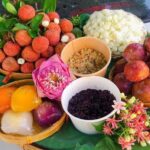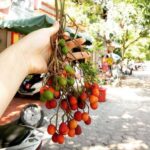Woody vine is a climbing plant that grows by coiling its tendrils around other plants, with stems reaching lengths of up to 5 to 10 meters. Its slender, brittle stems are as thin as toothpicks and branch out extensively to form a dense network of vines.

Bò Khai leaves have long stalks, ranging from 3 to 10 cm in length. They are oval-shaped, tapering to a point, and have a light green hue. The young shoots of the plant resemble those of the su su plant, known for their soft and succulent texture.
Bò Khai vines flower and fruit from April to June each year. The flowers grow in clusters at the leaf axils, with each flower having five petals. The fruits are berries, oval in shape, and turn yellow or red when ripe, containing a single egg-shaped seed.

Flowers and fruits of the Bò Khai vine.
This type of vine is commonly found growing wild in the mountainous provinces of northern Vietnam, including Thái Nguyên, Bắc Kạn, Cao Bằng, and Lạng Sơn. In the past, it was foraged and cooked during times of food scarcity as a means of staving off hunger.
However, with a growing appreciation for natural cuisine and traditional dishes, Bò Khai vine has now become a delicacy sought after by urban dwellers. The price of Bò Khai vine currently ranges from 50,000 to 75,000 VND per kilogram, depending on the season. It can be prepared in a variety of delicious ways, including stir-frying with garlic, scrambling with eggs, making soup, or simply boiling and dipping in fish sauce.
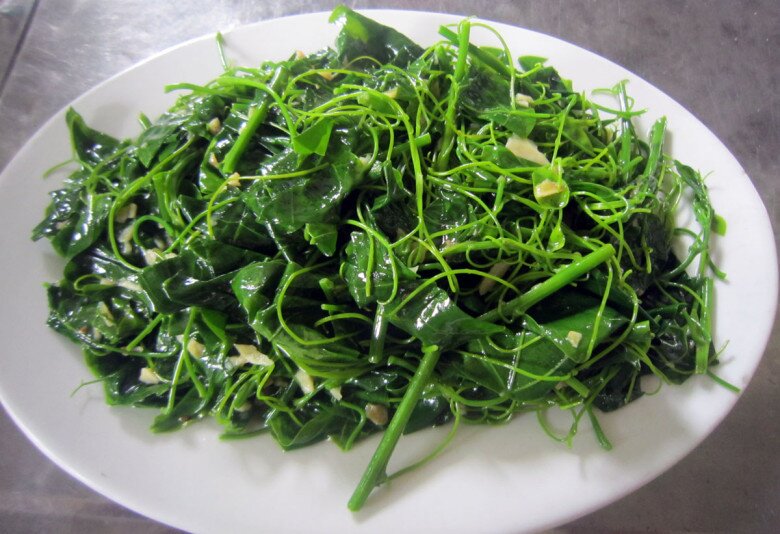
Stir-fried Bò Khai vine.
One distinctive feature of Bò Khai vine is its pungent aroma, which some may find off-putting at first. However, once accustomed to it, the unique flavor profile becomes appealing, offering a sweet aftertaste and a satisfying crunch. To mitigate the strong scent, it is common practice to rub the vegetable with salt, vigorously knead it, and then rinse it multiple times before cooking.
Beyond its culinary uses, Bò Khai vine is also valued for its nutritional and medicinal properties. Scientific studies have revealed that it is rich in fiber, protein, vitamin C, calcium, and phosphorus, making it highly beneficial for overall health.

In traditional Vietnamese medicine, Bò Khai vine is considered to have a neutral nature and a slightly bitter taste. It is prized as a medicinal herb for its ability to clear heat and detoxify the body, aiding in the treatment of various ailments. Both the stems and leaves can be dried and used as herbal remedies. The decoction made from Bò Khai vine is believed to be particularly beneficial for liver health and is often used to support the treatment of hepatitis.
Additionally, the decoction is said to possess anti-inflammatory properties, aid in kidney stone dissolution, promote diuresis, alleviate kidney edema, enhance digestion, and stimulate appetite. People in highland areas often boil the plant to make a daily health-boosting drink. Women and children can consume the cooked decoction, while men may choose to soak the vine in alcohol for long-term use.

Growing and Caring for Bò Khai Vine at Home
Being a wild-growing plant, Bò Khai vine is relatively easy to cultivate. It is resistant to pests and diseases and adapts well to different soil conditions. You can grow it in your garden or utilize large pots or buckets on your rooftop or balcony.
The primary method of propagation for Bò Khai vine is stem cutting. For this, select a stem from a mother plant that is 3 to 4 years old, cut a segment 6 to 10 cm in length, ensuring it has at least 2 to 3 leaf nodes. Immediately immerse the cutting in water after cutting to prevent dehydration. Before planting, you may apply root-stimulating hormones to the base of the cutting.
Next, insert the cutting 2–3 cm deep into the soil and gently press the surrounding soil. Before long, the cutting will take root.
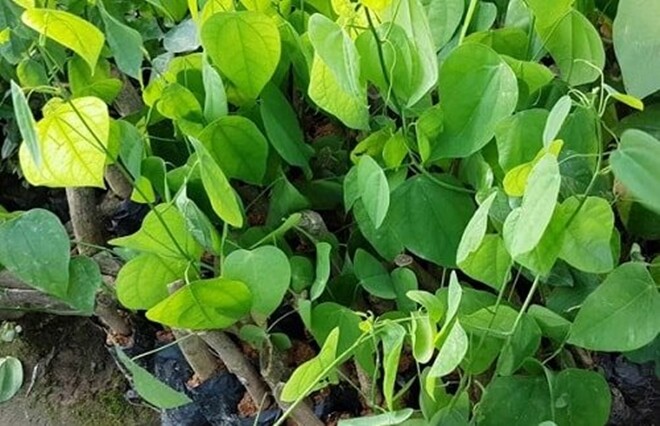
While Bò Khai vine is generally low-maintenance, if you want your plant to thrive and produce abundant young shoots, consider the following factors:
– Soil: Bò Khai vine is not particular about soil type, but it’s essential to loosen the soil to make it airy and porous. Add compost before planting. If planting in a garden, space the holes 60–70 cm apart, with each hole measuring 30x30x30 cm. Plant 1–2 cuttings per hole. For container gardening, choose deep pots, and plant only 1–2 vines per pot.
– Light: During the initial stages, the young plant requires low light levels, so place it in a shaded area. As the vine matures, gradually expose it to more sunlight for optimal growth.
– Watering: In the early stages, the plant needs ample water, so water it once or twice a day. As the vine grows, adjust the watering frequency according to the weather conditions.
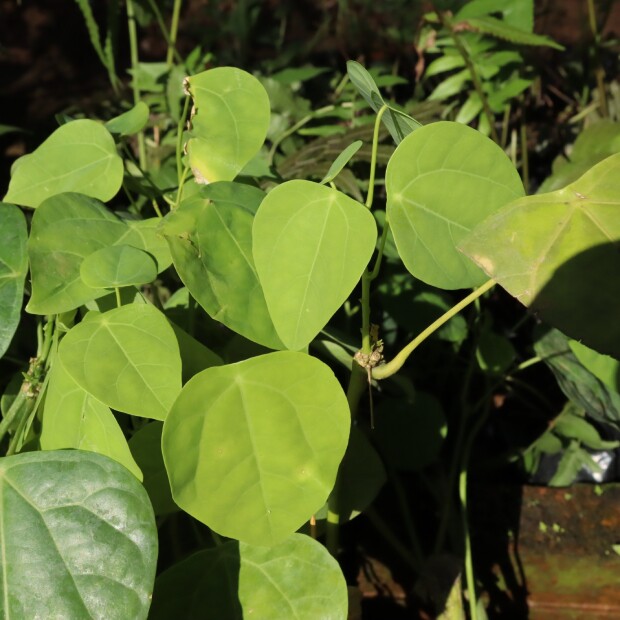
– Fertilizer: For the best results, use compost or worm castings as a base fertilizer. Periodically apply NPK fertilizer in combination with organic matter to promote healthy growth.
– Pest and Disease Control: Bò Khai vine is generally resistant to pests and diseases. Ensure good soil drainage and avoid waterlogging. Regularly prune old leaves and dry branches, cutting close to the base, about 10–15 cm from the ground, to encourage new growth.
– Harvesting: Bò Khai vine can be harvested year-round, especially during the rainy season. Only pick the young shoots to allow the plant to continue growing. On average, it takes 4–5 days for new shoots to appear.
Delicious Delights: Uncover the Secrets to a Healthy and Tasty Dragon Boat Festival Feast
As we approach the festive season of Tết Đoan Ngọ, it’s important to note that while there is a plethora of delicious dishes to indulge in, some combinations may not sit well together. The array of flavors, from sour to spicy and salty to sweet, each has its unique effect. However, it is crucial to be mindful of certain food pairings that could potentially impact your health.
Weed: The Ultimate Detox King, Now a Delicacy Worth 160,000 VND per kg, Easy to Grow and Harvest Year-Round.
As a versatile vegetable that is both a delicious ingredient and a valuable medicine, this particular plant is becoming a staple in modern households. With just a few pots on a balcony or rooftop, homeowners can enjoy a year-round supply of fresh, chemical-free produce, bringing peace of mind to the table.
Does Matcha Make You More Alert Than Green Tea? The Answer May Surprise You
Matcha is the latest beverage trend taking the world by storm, but does it live up to the hype? With a plethora of purported health benefits and a promise of enhanced focus and alertness, it’s time to delve into the world of matcha and uncover the truth. Uncover the secrets of this ancient beverage and discover why it might just be your new go-to drink.

























